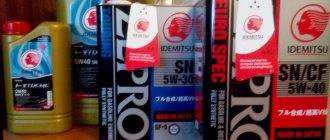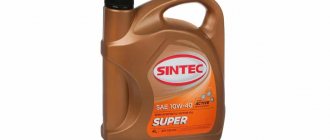In two-stroke power units, the lubricant dissolves in the fuel, and then burns simultaneously with it. Oil for four-stroke engines differs significantly from analogues used in two-stroke engines. It is of higher quality and retains its beneficial properties for a long time.
It contains a large number of special additives (at least 25%). Unlike other brands, there are no increased requirements for this oil in terms of ash content and opacity. Their level reaches elevated levels (ash content - more than 2%).
Features of the lubrication system of two- and four-stroke engines
Many consumers wonder what the difference is between 4-stroke engines and two-stroke engines. A specified amount of lubricant is constantly maintained in the crankcase of a four-stroke power unit. From there it is supplied to the lubrication system under the influence of an oil pump.
As a result, an oil film forms on the pistons. In this case, there is no friction when it slides along the cylinder walls. In order to prevent the penetration of oil fluid into the combustion chamber, oil scraper rings are installed that cut off lubricant leaks, directing them back to the crankcase.
The lubrication system of two-stroke engines is based on mixing fuel with motor lubricant in a ratio of 50/1. Modern automobile oils have the unique property of self-mixing. If there is not enough substance to fully lubricate the working surfaces of the cylinders, the power unit operates “dry”. At the same time, the overall engine life is sharply reduced.
More powerful two-stroke engines over 40 hp. With. equipped with a special tank for automobile oil. It automatically dispenses and mixes the mixture in the correct proportions.
The disadvantage of 2-stroke lubrication systems is a decrease in combustion efficiency due to the content of oil particles in gasoline. Opening the intake and exhaust valves also negatively affects the performance of the power unit. In this case, a large release of unburned mixtures into the environment occurs.
Basic requirements for engine oil for a two-stroke engine
In a two-stroke engine, the lubricant used is used not only to reduce friction forces. A significant part is used in the combustion process. Therefore, there are certain differences between engine oils operating in different cycles.
Once combustion occurs, the content of plasticizers created on the basis of heavy metals should be minimized in the exhaust products
It is especially important for small-sized power plants, which during operation are located near the user’s face (gasoline trimmers and chain saws)
Experts highlight the following advantages of motor oils for two-stroke internal combustion engines:
- the rubbing elements are fully lubricated. For loaded components of the crank mechanism, it is necessary to ensure penetration into the gap between the contacting parts. An oil film on the inner surface of the cylinder will prevent scuffing when the piston moves;
- Lubrication prevents corrosive wear. The available additives will prevent high-temperature corrosion from occurring. Rust does not form on the surface of parts containing iron. This property preserves engine performance even after quite long periods of operation;
- the viscosity of the liquid allows it to withstand significant loads. The oil film has a high load-bearing capacity. It is not squeezed out under static and dynamic loads. The frictional forces when sliding through the separating layer of lubricant are reduced several times;
- Motor oil can dissolve in gasoline at different concentrations of components. No clots are formed that can clog small flow sections (nozzles).
Differences between 2 and 4 stroke oils
Due to the presence of design differences in the lubrication systems of these engines, the requirements for lubricants differ significantly:
- For two-stroke engines, a necessary condition is the ability to burn the oil as completely as possible. In this case, a minimal amount of soot (soot and ash) is formed.
- In four-stroke engines, the main requirement for motor oil is long-term provision of lubricating effects by preserving the beneficial properties of the material used.
Previously, the method of simple petroleum distillation was used in the manufacture of lubricants. The resulting product was suitable for lubricating parts and assemblies, engines of any kind. Their technical characteristics met the requirements of motors with low power, low friction force and little wear at the interfaces of parts.
With the increase in performance indicators and engine speeds, the need arose to create motor oils with new capabilities. Additives have begun to be added to lubricating fluids, which significantly improve the technical parameters of lubricant products:
- reducing wear;
- antioxidant;
- anti-foam;
- anti-scuff;
- detergents.
Modern motor oil for 4-stroke engines contains additives in an amount of 25% of the total volume. For such liquids there are no increased requirements for ash and soot levels.
Why is filling a 2-stroke engine with 4-stroke oil harmful?
Motor oil for four-stroke engines is not recommended for use in two-stroke power units. When the mixture burns, ash is formed, which forms a deposit in the combustion chambers and pistons.
When combined with lubricant, combustion residues turn into abrasive powder. Sharp abrasives cause irreparable damage to the mirror surfaces of cylinders, significantly reducing their service life.
Soot is very harmful to the performance of piston rings. It gets clogged into the grooves, as a result the rings lose mobility, and engine power decreases sharply. Soot deposits also accumulate in the exhaust system, narrowing the clearance in the pipe, making it difficult for exhaust gases to escape and causing additional power losses.
Carbon ash and soot deposits on pistons and cylinders cause detonation. In this case, the operational life of the power unit is sharply reduced. Coking of the electrodes and spark plugs leads to their short circuit and blocking the engine.
Differences in oils for two-stroke and four-stroke engines
The fundamental difference between a two-stroke engine and a four-stroke engine is that the two-stroke engine is lubricated with oil that is previously dissolved in gasoline and ultimately burns with it.
There are two-stroke engines with a separate oil supply system to the crankcase, but this does not change the essence of the matter: the oil still burns along with gasoline. In four-stroke engines, on the contrary, every precaution is taken to prevent oil from entering the combustion chambers. This leads to the main differences in the requirements for oils: in two-stroke engines, the oil must burn as completely as possible, leaving a minimum of deposits in the form of soot and ash, and in four-stroke engines, the oil must ensure stable lubricating properties for as long as possible.
At the dawn of the era of internal combustion engines, lubricating oils were obtained by simple distillation of oil and were used in both types of engines, since the specific power of the first engines was low, and the loads on the mating parts and the wear they caused were low. Later, however, with an increase in operating speeds and specific engine parameters, the capabilities of such oils turned out to be exhausted. In search of a way out of this situation, it was proposed to use special additives in oils - additives that significantly improve certain oil parameters.
A whole range of additives are usually added to oils: anti-wear, extreme pressure, detergent, anti-foam, antioxidant, etc. As a result, the additive content in modern four-stroke engine oil can reach 25%. Since oils for four-stroke engines are not subject to special requirements in terms of combustion efficiency, additives are selected without taking into account ash content, as a result, the ash content of oils can reach 2% or more, and the smokiness of these oils is also high.
What happens when using “four-stroke” oils in two-stroke engines? It's very simple: the ash formed during the combustion of oil settles on the piston and the walls of the combustion chambers, forming an abrasive powder mixed with oil that acts on the cylinder bore and piston, like real sandpaper! The parts are literally sawed off by this abrasive and serve much less than they could in more favorable conditions. Soot also causes no less harm: settling in the grooves of the piston rings, it contributes to the loss of ring mobility and, as a result, causes a loss of engine power. Deposited in the exhaust windows, soot gradually reduces their cross-section, causing difficult exhaust gases and, again, loss of power. In addition, carbon deposits from ash and soot deposited on the pistons and cylinder heads contribute to the development of such harmful phenomena as detonation and glow ignition, which also lead to loss of power and reduced service life. When deposited on the electrodes of the spark plugs, carbon deposits cause them to short out and stop the engine.
Oils for two-stroke engines in the Russian consumer market
In the USSR, special oils for two-stroke engines were not produced at all, despite the widespread use of vehicles such as light motorcycles, mopeds, motorbikes and motor boats. Apparently, this was due to the fact that almost only cars and armored vehicles with four-stroke engines were used for military purposes in the country, and all “civilian” production developed on a residual basis.
True, the same oils mentioned above were produced without additives, which are better suited for lubrication of “two-stroke” engines, but during times of total shortage, only the famous “autoyl” AC-10 and AC-8 (M8-B according to the new GOST) were available to the average consumer ).
As a result, motorists and watercraft enthusiasts were forced to “saw” their engines with ash, reducing their service life by at least two times (according to various oil researchers, from 2 to 4 times). It is the use of unsuitable oils that explains the supposedly shorter service life of domestic engines compared to foreign-made engines. In countries that produce two-stroke motorcycles, the production of special low-ash oils for two-stroke engines was mastered many decades ago, and data on engine life is provided for the case of using these very high-quality oils.
The first domestic special oil for two-stroke engines M-12-TP was developed in the late 70s of the last century in connection with the increase in export logging volumes. The Druzhba chainsaws used in logging operations simply “burned” under harsh operating conditions.
The desire to reduce sharply increased costs explains the development of the start of production of the long-awaited oil. However, this oil never went on general sale in those years.
Imported oils for two-stroke engines, and after this, the production of domestic “two-stroke” oils M-12-TP and MGD-14M increased so much that even in remote regions of Russia there was no longer a problem in purchasing them. The author of the site switched to using special “two-stroke” oils shortly after the start of operation in 1994. new "Veterok-8M". The fact is that at the end of the 80s there were some changes in the manufacturing technology and composition of the usual M8-B car, as a result of which this oil began to precipitate from the fuel mixture after a day's sedimentation. As a result, when trying to start the engine, there was mostly oil in its carburetor, and even the Veterok-8M with its powerful ignition system started with difficulty. These newfound “properties” of Autol finally confirmed my decision to use special oils. At first, these were motorcycle oils made in South Korea, costing $2.5 per liter, and even then when purchased in boxes. Subsequently, high-quality domestic oil MGD-14M appeared on free sale in Vladivostok, which in 2001. costs 48 rubles for a 2-liter flask. The high qualities of this oil are confirmed by comparative tests of various oils organized by Moto magazine.
Types of four-stroke motor oils
The most popular among users is motor oil for a four-stroke power unit that meets the JASOMA-2, APISN specifications. Domestic oils produced in accordance with GOST 17479.1-85 are adapted to the requirements of the SAE system.
Automakers recommend filling a four-stroke engine with a lubricant with a viscosity level from 5-W20 to 10-W40. It has been noticed that the higher the oil viscosity, the better the results at high ambient temperatures.
Like all lubricants, motor oil for a 4-stroke engine has the following varieties:
- Synthetic motor oil. It does not form carbon deposits and has many positive characteristics. It is used for extreme trips.
- Semi-synthetics and high-quality mineral lubricants are wear-resistant, smoke-free during combustion, and keep the engine clean. Recommended for daily use.
- Special semi-synthetics. These types of lubricants are used when working on low-grade fuel. Thanks to the included additives, this oil is characterized by excellent cleaning properties, low waste consumption, and preservation of beneficial qualities over a long period.
Types of oil
Two-stroke oil is a separate lubricant for internal combustion engines. These lubricants differ from others in their properties. As already noted, special requirements are imposed on two-stroke oils.
For gasoline 2-stroke engines, oils must have the following qualities.
- The minimum amount of ash and coke that are formed in the cylinder during combustion. The lubricant, ideally, should burn out completely.
- It should dissolve easily and completely in the fuel.
- The lubricant material must have lubricating, anti-wear, and protective properties at elevated temperatures. It should also provide good protection against corrosion.
If the lubrication system is separate , then it is necessary that the oil remains fluid and pumps well.
If we take into account the scope of application and specifics of 2-stroke engines, which serve as engines for scooters and mopeds, engines for lawn mowers, boat engines and others, then there are separate requirements for the toxicity of the material. If the lubricant gets on the ground, it should be as safe as possible for the environment, and if it gets into water, it should decompose very quickly.
Such oils must comply with TC-W3 and 2 T standards. Very often they can be distinguished from analogues by color, since they are additionally colored. They are mostly blue in color. Even when mixed with gasoline, it is clearly visible.
According to the 2 T standard , such lubricants are used in air-cooled engines ranging from lawn mowers and chainsaws to (light) motorcycles. But for use in water-cooled outboard motors and jet skis, oils of the TC-W3 standard are designed.
Choosing the right 4-stroke engine oil
For ordinary consumers, the most determining factors when choosing a suitable brand are the viscosity of the motor lubricant and its quality.
Based on viscosity, the lubricant is selected based on the SAE tables according to three criteria:
- lubricant used in engines in summer, SAE 20, 30, 40;
- winter materials from SAE 0W to SAE 25W;
- all-season automobile oils.
In addition to the basic base, all-season tires contain special additives. They dilute the lubricant to speed up engine starting in winter cold. At the same time, with their help, all working elements of the engine are reliably protected from harmful oxidative processes and high friction forces.
Designation of all-season motor oils according to SAE: 10W30, 14W40, etc. The number in front indicates the lowest air temperature at which the oil will not begin to thicken. The last numbers are the maximum permissible ambient temperature for normal, uninterrupted operation of the engine in the summer heat.
Compound
Various additives are added to oils, which is why two-stroke and four-stroke differ from each other. In addition to the main components, two-stroke oils contain a solvent. It is thanks to it that the miscibility of fuel and oil increases, pumping and atomization are facilitated. But at high temperatures, solvents (20%) negatively affect lubricating properties. Additives increase viscosity, so you should choose a product with a higher viscosity coefficient - this oil is of better quality.
In addition to the solvent, two-stroke oil contains the following substances:
- Oil base - approximately 60%.
- The vacuum residue (the result of the primary distillation of petroleum products) is 5−17%.
- Solvent - 20%.
- Additives that are used to reduce smoke and soot from the waste product - the rest.
Basic properties
The functions of lubricants are:
- prevention of corrosion on parts of the mechanism;
- ideal cooling (heat removal that is created by friction of mechanisms);
- preventing scuffing and improving engine wear resistance;
- reducing friction between engine elements to a minimum.
With the correct selection and use of a lubricant, the engine will last as long as possible.
Source
Selection of oil quality in accordance with API specification
The quality level of motor oil according to this system is indicated by two Latin letters. The first indicates that the product belongs to the group of materials intended for gasoline or diesel engines - S and C, respectively. The second letter is the direct quality level of the product. Oils of the SL, SJ, SH brands are very popular. While classes SM, SE, SF, SG are used extremely rarely.
When producing motorcycles, manufacturers indicate the types of motor oils recommended for use in a particular vehicle. This information is placed on branded stickers and on engine filler plugs.
Using a higher class lubricating fluid is impractical. However, if operating conditions are more complex, it is recommended to use machine oil with a higher viscosity index.










